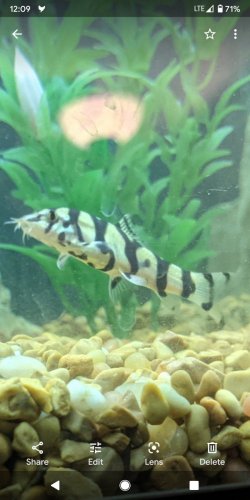This question is by no means easy to answer. SF has the species
Sinibotia pulchra for the common name "Golden Zebra Loach" and this is nothing like the
Botia species in your photo.
Sinibotia pulchra – Golden Zebra Loach (Botia pulchra, Botia gigantea) — Seriously Fish
This only points out the confusion that common names frequently cause. The entire
Botia species group including the "YoYo" loach is itself a muddle. The fish in your photo is almost certainly a species within this muddle group, and I see others have suggested
B. histrionica and I agree this is certainly likely. Some data I researched on this species when preparing profiles of the
Botia fish may be of assistance, so what follows comes from my profile.
Botia histrionica
Closely resembling
Botia kubotai in patterning, this is a similar quite peaceful but playful loach well suited to a community aquarium provided its needs are satisfied. It may appear in they hobby under common names such as Burmese Loach, Burmese Zebra Loach, and Golden Zebra Loach. Young (juvenile) fish are remarkably similar in patterning to young
B. kubotai.
Origin and Habitat: India and Myanmar; possibly western Thailand. Occurs in clear slow flowing mountain streams shaded by the forest. In the Ataran Riover (Myanmar) it occurs in company with Botia kubotai.
This species is very active, and as noted under Compatibility/Temperament needs a spacious aquarium with plenty of hiding spots so it can be kept in a group of at least 5 or 6, otherwise some members may be relentlessly picked on and succumb to stress and injury. A riverine aquascape would be ideal; a substrate of fine smooth gravel with smooth rocks representing boulders, caves made from bogwood or rock, and subdued lighting partially achieved with floating plants. Plants such as crypts,
Anubias and java fern for the lower areas. The current from the filter need not be excessive; this fish seems to prefer quiet pools in its habitat. Water must be stable; like all loaches, this species is intolerant of dissolved organics and nitrates should be kept below 10ppm, which can be achieved with live plants and regular weekly partial water changes.
Compatibility/Temperament: Generally peaceful, inquisitive and playful. Like all botine loaches they establish a social structure within the group and in-fighting is less with this species; a group of at least five is acceptable provided there are numerous hiding places in the aquarium. They can be combined with other peaceful loach species. Long-finned upper fish should be avoided to prevent fin nipping; suitable upper fish are barbs, larger rasbora, danios, characins.
Discussion [excerpted]
There is some variation in the patterning from fish to fish, and this may be geographical; Grant (2007) suggests that the populations with slightly different patterning may be distinct species. From time to time a fish may "gray out" as it is commonly called, usually two together and often during "fights" or when feeding. The base colour darkens considerably.
This species was described by E. Blyth in 1860 as
Botia histrionica. The description by Blyth states it has 5 bands on the body which are ‘broad and subregular in shape, each containing a small round spot at the lateral line and another on the ridge of the back. Dorsal-fin with one broad interrupted black band, and some black also at the base. Pectorals, ventrals and anal, each with two black bands; and the caudal also with two broad bands and a black tip to each lobe. It appears he was looking at an adult specimen as the size given is 4½ inches.
The subfamily Botiinae within the family Cobitidae is uncertain; Nalbant (2002, 2004) and Kottelat (2004) raised the subfamily to family status as Botiidae and divided it into two tribes:
Tribe Leptobotiini - containing the genera
Leptobotia, Parabotia, Sinibotia.
Tribe Botiini -
Botia, Chromobotia, Syncrossus, Yasuhikotakia.
Tang et.al. (2005) agreed. Slechtova et. al. (2006) basically agreed but proposed two Subfamilies rather than tribes, and moved one genus:
Subfamily Leptobotiinae -
Leptobotia, Parabotia.
Subfamily Botiinae -
Botia, Chromobotia, Sinibotia, Syncrossus, Yasuhikotakia.
References:
Grant, S. (2007), "Fishes of the genus
Botia Gray, 1831, in the Indian region (Teleostei: Botiidae),"
Ichthyofile, No. 2, pp. 1-106.
Nalbant, T. T. (2002), "Sixty million years of evolution. Part one: family Botiidae (Pisces: Ostariophysi: Cobitoidea),"
Travaux du Museum d'Histoire Naturelle "Grigore Antipa" 44, pp. 309-333.
Nalbant, T. T. (2004), "
Hymenphysa, Hymenophysa, Syncrossus, Chromobotia and other problems in the systematics of Botiidae. A reply to Maurice Kottelat,"
Travaux du Museum d'Histoire Naturelle "Grigore Antipa" 47, pp. 269-277.
Kottelat, M. (2004), "
Botia kubotai, a new species of loach (Teleostei: Cobitidae) from the ataran River basin (Myanmar), with comments on botiinae nomenclature and diagnosis of a new genus,"
Zootaxa 401, pp. 1-18.
Slechtova, V., J. Bohlen, J. Freyhof and P. Rab (2006), "Molecular phylogeny of the Southeast Asian freshwater fish family Botiidae (Teleostei: Cobitoidea) and the origin of polyploidy in their evolution,"
Molecular Phylogenetics and Evolution, 39, pp. 529-541.
Tang, Q., B. Xiong, X. Yang and H. Liu (2005), "Phylogeny of the East Asian botiine loaches (Cypriniformes, Botiidae) inferred from mitochondrial cytochrome b gene sequences,"
Hydrobiologia 544(1), pp. 249-258.
[Taxonomy accurate as of the date of writing, 2014]




